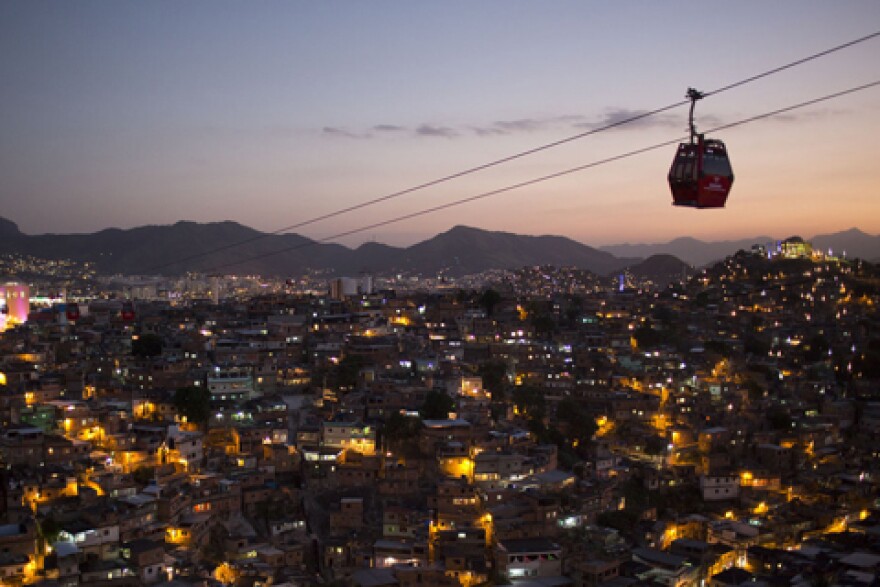The Cities Project focuses on "Where We Live, How We Live and How We Get Around." Each of these three elements will be featured in stories for Morning Edition and All Things Considered. The Cities Project is multi-platform, with interactive and visual elements online and a presence on social media that drives conversation. In addition to thematic reporting, look for accompanying "City Life" elements -- snapshots of the people that bring cities to life.
The old adage is that there are three key factors that matter in real estate: "location, location, and location." These reports focus on the larger implications of the locations we choose.
Managed Retreat
All Things Considered; Thursday, September 18
As the effects of climate change become more apparent and cities work to adapt, ecologists argue that "managed retreat" is the best defense against disaster. They point to signs that nature is already responding to sea level rise on the east coast -- vegetation changing, ghost crabs moving northward. Maybe we should take the hint, they say. Relocate existing development. Move homes and businesses away from shore. Don't fund new construction in the same places when they're destroyed. But Americans do not take well to the notion of being "managed" or "retreating" from anything. In Satellite Beach, Florida, NPR's Jon Hamilton finds a coastal community wrestling with what to do.
Staten Island Buyouts
Morning Edition; Friday, September 19
More than 500 homes are being torn down in areas where Hurricane Sandy did its worst in 2012. The owners have been bought out in a program designed to return the area to nature. In the words of NY Governor Cuomo, "there are some parcels that Mother Nature owns. She may only visit once every few years, but she owns the parcel." Environmentalists are heartened by this approach to "managed retreat" and Staten Island residents who saw their neighbors perish in the flood are glad for the opportunity to move away from the shore. Matthew Schuerman of member station WNYC tells us about the knock-downs happening in Staten Island and the plan to create a flood buffer zone for homes that remain.
Defend and Resist
All Things Considered; Thursday, September 25
As we approach the second anniversary of Hurricane Sandy, we hear how communities in New Jersey are rethinking their locations. Host Melissa Block talks with a homeowner in Woodbridge, New Jersey who -- after three floods in three consecutive years -- has decided her home should probably never have been there in the first place. She and her entire block are being bought out by the state. We talk with her on her moving day. Meanwhile, in two other parts of New Jersey, closer to Manhattan, there are evolving plans to defend communities from water. The federal government has awarded $150 million dollars for a proposal for the marshy region around the Hackensack River, known as the Meadowlands. The idea is to turn the marshes into a formal park -- and build berms to protect fourteen neighboring communities from flooding. NPR's Franklyn Cater gets a boat tour of the Hackensack and learns more about the plan, which won't be easy to implement.
The Built Environment vs. the Natural Environment
Friday, September 26
We tend to think of the built and natural worlds as separate places. There's the city and the country, urban and rural. Astrophysicist and NPR 13.7 blogger Adam Frank advances the idea that as the world urbanizes, we can't afford that kind of thinking. It's all part of a whole.
The Ghosts of Place
Morning Edition; Thursday, October 2
In most cities, there's a story to tell about which ethnic or cultural groups live in which neighborhoods and why. The reasons often have to do with decisions made long ago. One powerful example of this is in Beirut, where Lebanon's civil war ended 25 years ago. It's now an exhilarating, intoxicating city -- a battered mishmash of Ottoman, French, modernist buildings, with crazy traffic and a wild nightlife. But scratch that surface, and the sectarian divisions that sliced up the city during the war are still there. In the southern suburb, Shiite Hezbollah control everything and have posters of their Iranian patrons up. In Bohemian Hamra, the Syrian Social Nationalist Party have oil barrels with their flags, pictures of Assad, and armed men sitting around - between the hipster bars. There's a patchwork of Christian militias in the East, and the Palestinian camps have their own structure. Everyone's carved out turf, and co-exist relatively peacefully, until sometimes they don't and clashes break out. NPR's Alice Fordham reports.
The Cold War Encapsulated -- And Rekindled -- In A Single City
Morning Edition; Thursday, October 9
NPR's Soraya Sarhaddi Nelson reports on the troubled reinvention of one of Europe's most important capitals, Berlin. The Eastern and Western halves of the city are divided in spirit today as they were physically during the Cold War. When the Berlin Wall came down, the West German government decided to reinvent the city and return it to its Prussian splendor. They rushed to erase signs of division and spent billions to rebuild the deteriorated East, making it look more like West. But this redefining of Berlin angered many residents, especially those in the eastern part of the city. Some feel they were "annexed" and express alarm at the ongoing removal of Communist-era architecture.

